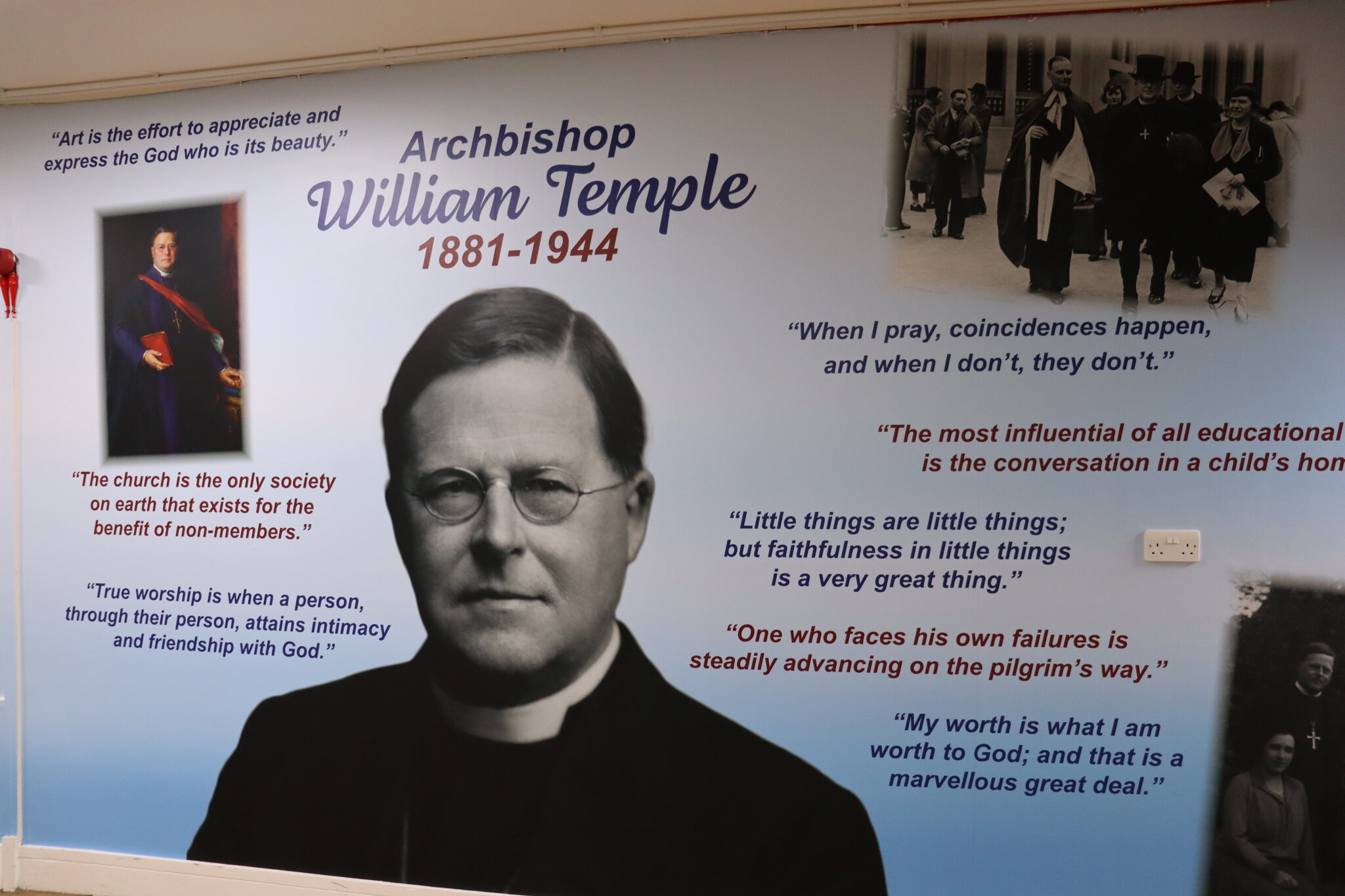 About Archbishop William Temple
About Archbishop William Temple
‘Archbishop William Temple was undoubtedly one of the great men of the twentieth century. The issues with which he concerned himself – social welfare for all, education, ecumenism and evangelism – remain at the heart of the Church’s life today. William Temple had immense gifts and, not least the ability to overcome the barriers of class, Christian denomination and political allegiance. He was recognised as both a man of God and a man of the people. Most of those who met him were inspired by the encounter.’ (Bishop Alan Blackburn in the Foreword to WILLIAM TEMPLE: A Calling to Prophecy by Stephen Spencer)
Archbishop William Temple (1881-1944) was a remarkable and influential man. As a school, we should be very proud to be named after him. He was Bishop of Manchester, then Archbishop of York before becoming Archbishop of Canterbury in 1942.
When he became Archbishop of Canterbury, the country was facing many difficulties, especially the continued threat of Nazi aggression. At that very dark time during the Second World War many people were expecting and fearing a Nazi invasion, and Archbishop Temple was a leader who encouraged people to hope.
Archbishop Temple also publicly supported Jewish people at a time when anti-Semitism was widespread, and the persecution of the Jews under Hitler was at its height. He co-founded an organisation called the Council of Christians and Jews (CCJ) which is still a powerful organisation supporting interfaith dialogue.
However, Archbishop Temple is probably best known for his work for social justice. He believed in the rights of all people, whether they are rich or poor. He also was a driving force for the 1944 Education Act, which provided free education to all children. Archbishop Temple believed that human freedom depended on society as a whole, in particularly the state having a positive role through education to equip people properly for a purposeful and creative life in which they could play their part in moving society forward.
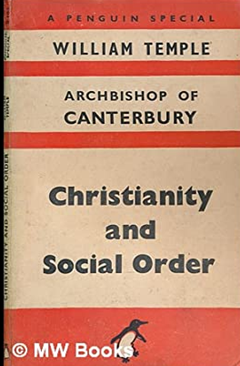 In 1942, Temple wrote Christianity and Social Order. In it he encouraged Christians to call upon Government to prioritise certain things, such as:
In 1942, Temple wrote Christianity and Social Order. In it he encouraged Christians to call upon Government to prioritise certain things, such as:
- Every child should be a member of a family housed with decency and dignity, so that they could grow up happily and unspoilt by underfeeding or over-crowding or by dirty and drab surroundings.
- Every child should have the opportunity of an education in order to develop fully. This education should throughout be inspired by faith in God and find its focus in worship.
- Every citizen should have sufficient leisure time, with two days of rest a week and if an employee, annual paid-leave in order to enable them to have a full personal life and opportunity to develop interests and talents.
- There should be freedom of worship, speech, assembly and of association for special purposes. (Temple, 1950, (1942), p.99)
One of the practical things that Archbishop Temple did was to create the Diocese of Blackburn, the diocese in which our school and local churches reside. He was Bishop of Manchester at the time but this diocese was getting too big and difficult to manage. He looked at options for creating a cathedral in Preston, Lancaster and Burnley but opted for Blackburn. There were many practical reasons for choosing Blackburn over the other areas including the train links and the potential to develop the church which would then become the cathedral.
So as a school we are named after a very special person, and we would do well to remember his work to bring about justice to different groups of people. But his life’s work was firmly based in his Christian faith. He summed up his beliefs, and that of other Christians, in these words.
“My worth is what I am worth to God; and that is a great deal, for Christ died for me.”
|
In 1965 Mrs Frances Temple was asked by the then Chair of Governors of William Temple School to recall her husband’s favourite Bible verse. In her letter of reply she says, “The text that comes to mind is one he quoted to me one August day when we were looking down on the loveliness of Buttermere Lake. I cannot remember where to find it – so can only quote from memory. “Eye hath not seen, nor ear heard, neither hath it entered into the heart of man what good things God hath prepared for them that love him”. We were having a picnic looking at Buttermere and we were talking about the future life – and he went on to say, “if it’s something better than this then it must be pretty good”. “No eye has seen, no ear has heard, and no human mind has conceived the things God has prepared for those who love him.” (1 Corinthians 2:9) |
Archbishop William Temple said many wise things, a large display in school (pictured above) reminds us of them. Here are some more of the quotes that are attributed to him:
Worship and Faith
When I pray, coincidences happen, and when I don't, they don't.
To worship is to quicken the conscience by the holiness of God, to feed the mind with the truth of God, to purge the imagination by the beauty of God, to open the heart to the love of God, to devote the will to the purpose of God.
True worship is when a person, through their person, attains intimacy and friendship with God.
We shall say without hesitation that the atheist who is moved by love is moved by the Spirit of God; an atheist who lives by love is saved by his faith in the God whose existence (under that name) he denies.
The Church is the only society that exists for the benefit of those who are not its members.
Character and Life
The first ingredient in conversation is truth, the next good sense, the third good humour, and the fourth wit.
Humility does not mean thinking less of yourself than of other people, nor does it mean having a low opinion of your own gifts. It means freedom from thinking about yourself at all.
The best rules to form a young man are: to talk little, to hear much, to reflect alone upon what has passed in company, to distrust one's own opinions, and value others that deserve it.
A man's wisdom is his best friend; folly, his worst enemy.
The greatest medicine is a true friend.
The greatest pleasure in life is love.
Little things are little things; but faithfulness in little things is a very great thing.
Art is the effort to appreciate and express the God who is its Beauty.
Science has its being in a perpetual mental restlessness.
The most influential of all educational factors is the conversation in a child's home.
One who faces his own failures is steadily advancing on the pilgrim's way.
Our School Badge
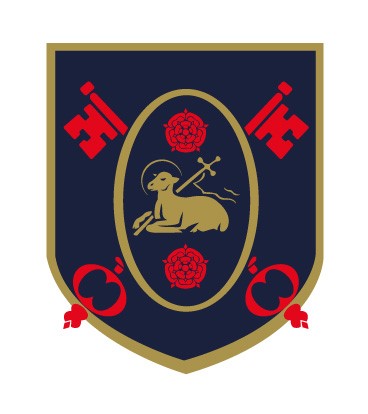
The school opened in 1963 and the school badge has been the same design since its opening.
The badge combines the symbols from the coat of arms for the Blackburn Diocese and Preston.
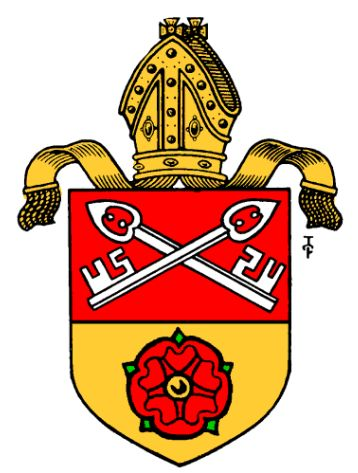
The Blackburn Diocese arms were officially granted on February 19, 1927.
The arms combine the crossed keys of St. Peter with the rose of Lancashire, where the diocese is situated. Aside from our school being geographically located in the Blackburn Diocese, William Temple actually created the diocese when he was Bishop of Manchester.
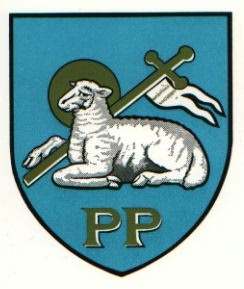
The Preston coat of arms includes the lamb. This is a symbol which is seen lots in religious iconography. One of the terms used to talk about Jesus is Lamb of God. This links with how animals were often sacrificed to show devotion to God. Christians believe that Jesus’ death on the cross was the ultimate sacrifice and shows that there was no need for any future animal sacrifices.
The lamb is also the coat of arms for St Wilfrid, the patron saint of Preston. St Wilfrid was involved in spreading Christianity from about 664 AD to his death in 709 AD. St Wilfrid is said to have donated land upon which Preston was founded – Priest Town. (Preston – from Anglo-Saxon Preost Tun – means settlement of the Priest). Some even think that St Wilfrid was the person who brought Christianity to Preston during Anglo-Saxon times.
Until the Reformation, Preston parish church was dedicated to St Wilfrid. Then came a name change to St John’s, and now it is referred to as Preston Minster. St Wilfrid’s became the name of the Roman Catholic church in Chapel Street, which leads off Fishergate into Winckley Square.
Many people think that the PP on the logo means Proud Preston. However, the origins are likely to have been Princeps Pacis - Prince of Peace, again a reference to Jesus and possibly showing that Jesus is the protector of the city. The PP has gradually evolved to be locally known as Proud Preston.
